by George Lakey
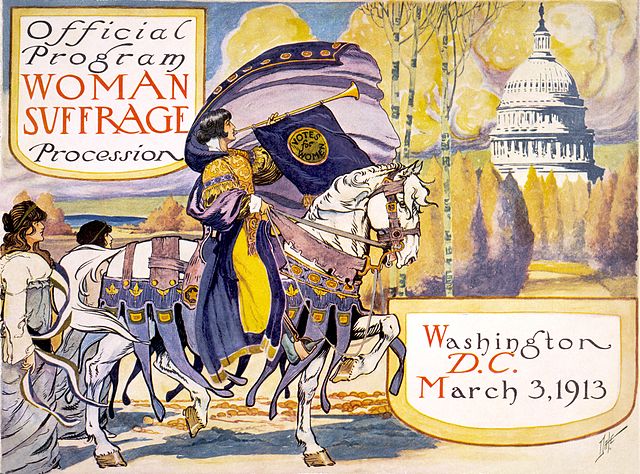
Cover of program for the 1913 National American Women's Suffrage Association march; courtesy Wikipedia.com
Suffragette is a 2015 British film directed by Sarah Gavron. It tells a gripping story drawn from the direct action wing of Britain’s woman suffrage movement. Because it spotlights one tactic — property destruction — the film raises the question of effectiveness. Leader Emmeline Pankhurst’s (1858–1928) argument for escalating with arson and explosions was to hasten their win. Did it?
Read the rest of this article »
by Henry S. L. Polak
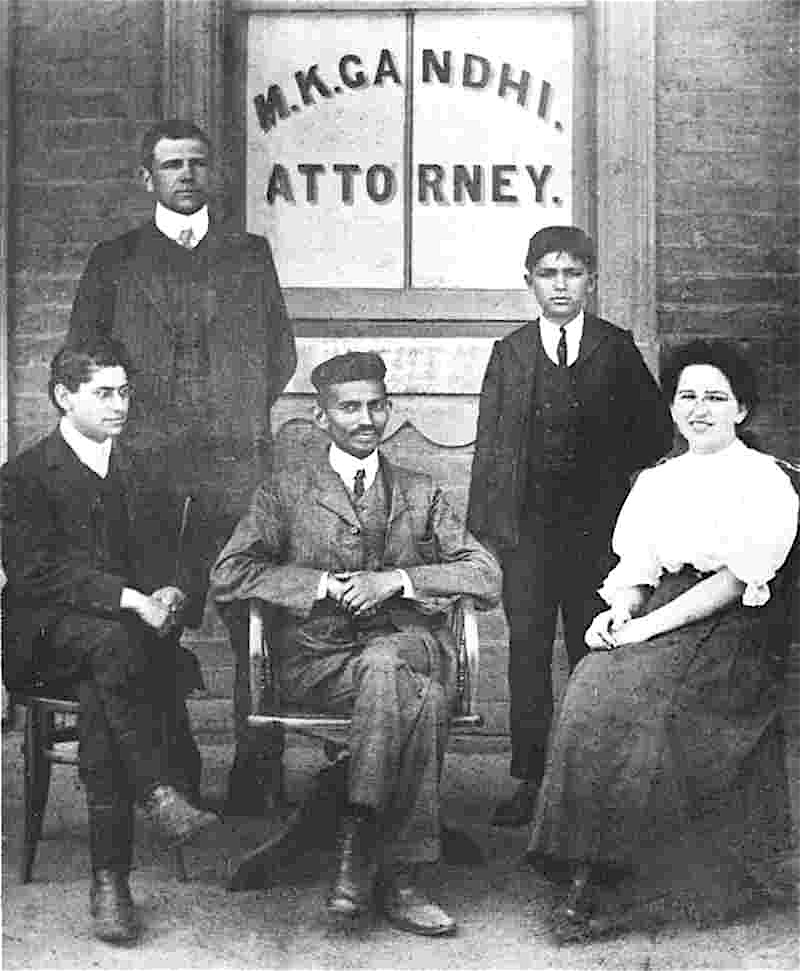
Gandhi in front of his Johannesburg law office, 1905, with Henry Polak (left), Sonia Schlesin; others unidentified.
Editor’s Preface: This 1949 article by Polak is often cited as a primary source of information about Gandhi’s South African years and the events surrounding Gandhi’s coining of the term, “Satyagraha”. Henry S. L. Polak edited Indian Opinion, which he co-founded with Gandhi and is credited with giving Gandhi a copy of Ruskin’s Unto This Last, which Gandhi cites as one of his most important influences. For further biographical and textual information please see the notes at the end. JG
Mahatma Gandhi’s technique of Satyagraha, or, as it was first known, Passive Resistance, had its origins in South Africa. It was in 1906, twelve years after Gandhi’s arrival there, that the flame of Satyagraha began to glow. Until then, the Indian grievances had been dealt with in the usual orthodox ways of petitions, memoranda, addresses, questions in Parliament, public speeches, and so on. But the time had now arrived when, all these having proved fruitless, new and radical methods had to be devised, their consequences considered, and redress thereby determined upon, at whatever cost to those suffering under social, economic, and political disabilities that must no longer be tolerated.
Read the rest of this article »
by Benjamin Naimark-Rowse
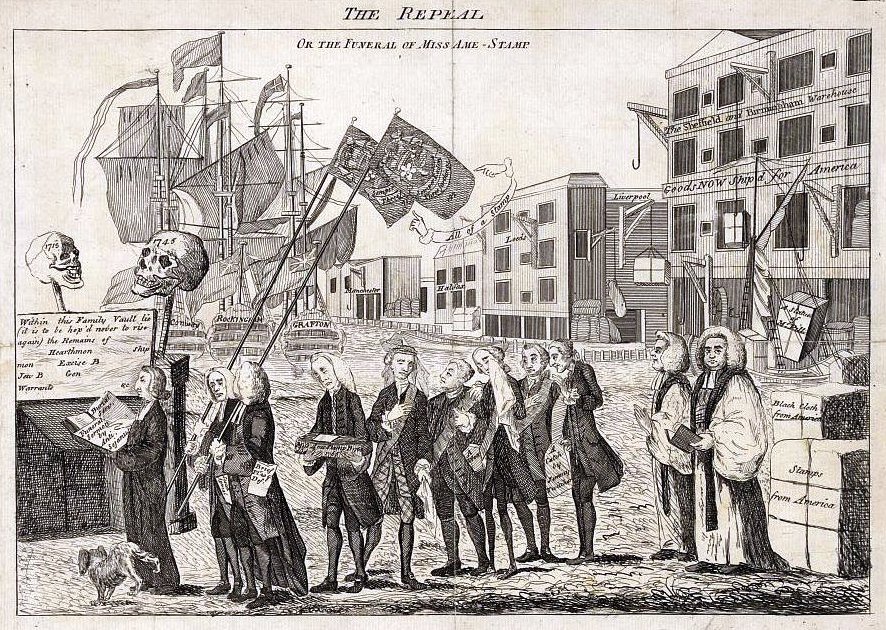
The Stamp Act repeal depicted as a 1765 funeral procession; courtesy commons.wikimedia.org
On the Fourth of July, cities and towns from coast-to-coast across the United States host fireworks, concerts, and parades to celebrate our independence from Britain. Those celebrations will invariably highlight the colonial soldiers who overcame the British. But the lessons we learn of a democracy forged in the crucible of revolutionary war tends to ignore how a decade of nonviolent resistance before the shot-heard-round-the-world (1) shaped the founding of the United States, strengthened our sense of political identity, and laid the foundation of our democracy.
Read the rest of this article »
by Rajendra Prasad
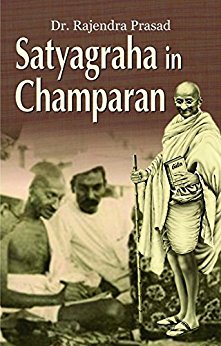
Dustwrapper art courtesy Ocean Books; oceanbooks.in
Editor’s Preface: The historical accounts of the Indian nonviolent independence movement generally focus on Mahatma Gandhi’s campaigns, whereas the Satyagraha Movement was widespread across India, with more than one leader. Rajendra Prasad (1884-1963) was one such. The account that follows draws a vivid picture of the courage and sacrifice of the campaign that Prasad led in 1930 in his home state of Bihar. His leadership qualities and commitment to nonviolence were well recognized; when India gained independence from Great Britain in 1947 he was chosen its first president. Please see our explanatory endnotes, note on the text, and editor’s note at the end of the article. JG
An outstanding example of the faith and firmness with which people acted on Mahatma Gandhi’s words was provided, in 1930, at Bihpur in Bhagalpur. (1) Bihpur is on the banks of the Ganges and is exposed to floods. The river always changes its course, as happens in all places near the Ganges. As a consequence, the boundaries marking off one man’s field from another’s are washed away, and when the floods subside, very often conflicts arise among rival claimants of land. […]
When I was touring that region in 1929, I found evidence of great enthusiasm among the people. I was convinced that when Satyagraha was started, its inhabitants would enthusiastically participate in it. I carried this impression because of an incident which occurred there. In the course of my tour, I had fixed up a meeting to be held at a particular place about two o’clock in the afternoon. I had been to another village at some distance from the place where the meeting was to be held, and had hoped to return in time for it. While I was on my way back, heavy rain came down suddenly, a strong wind began to blow, and I was delayed for two or three hours. When I arrived, soaked to the skin, I found a very big crowd which, I was told, had been awaiting my arrival in the rain for some hours. The rain itself was still falling. I stood up in the crowd in the rain and talked to them. It was this incident which impressed itself on my mind that the people of that region had courage as well as determination.
Read the rest of this article »
by Mohandas K. Gandhi
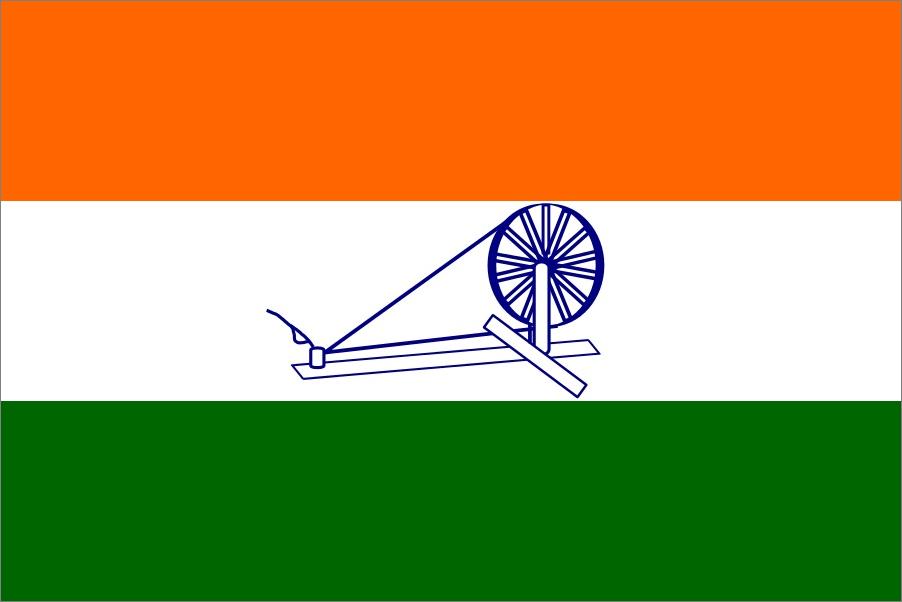
1929 proposed flag of India, with Gandhian spinning wheel; courtesy en.wikipedia.org
Editor’s Preface: The Indian National Congress formally approved “The Declaration of the Independence of India” on December 19, 1929, and it is important to understand it in its historical context. (1) Purna swaraj can be translated as “complete, sovereign independence,” that is, Indian independence from Great Britain and the ending of colonial rule. Various models had been proposed for Indian sovereignty prior to 1930, including several versions of power sharing. However, a sequence of events by the British government, violating or curtailing Indian civil rights, resounded as a betrayal to Gandhi. The “Declaration” marks a turning point in Gandhi’s thinking about Britain, and the nature of India’s future relationship with British rule. (2) There has been some disagreement as to its authorship, but Gandhi can be said to have solved the matter in February 1937 when he wrote,“ I was its author. I wanted the people not merely to repeat the mantra of independence but to educate the people as to its why and wherefore.” (3) Purna Swaraj was to be read throughout the country on January 26, 1930, and that date is still celebrated as India Independence Day. Please also see our explanatory notes at the end. JG
Purna Swaraj
We believe that it is the inalienable right of the Indian people, as of any other people, to have freedom and to enjoy the fruits of their toil and have the necessities of life, so that they may have full opportunities of growth. We believe also that if any government deprives a people of these rights and oppresses them the people have a further right to alter it or to abolish it. The British Government in India has not only deprived the Indian people of their freedom but has based itself on the exploitation of the masses, and has ruined India economically, politically, culturally, and spiritually. We believe, therefore, that India must sever the British connection and attain Purna Swaraj, or complete independence.
Read the rest of this article »
by Pace e Bene
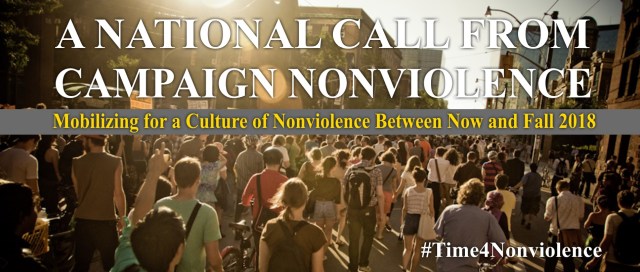
Banner illustration courtesy paceebene.org
Editor’s Preface: Pace e Bene is the organizer of Campaign Nonviolence (CNV). We post here their call to mobilize as another in our series of statements of purpose by nonviolent organizations. CNV aims to build a broad coalition united in its efforts to hold the Trump administration accountable through nonviolent action and protest. Please note that we have also posted a series of articles tracing the history of US nonviolence to its roots in Quaker, pre-Revolution Pennsylvania. CNV can, therefore, be seen in an historical context as a quintessentially American movement. Above all, the Campaign demonstrates how vibrant and hopeful nonviolent resistance is today in a divided America. JG
The Call for a Culture of Nonviolence
In the face of the Trump Administration’s priorities—demonizing immigrants, dismantling social programs, destroying environmental safeguards, diminishing civil rights, and dramatically increasing the prospect of war—we call on you, and your loved ones, and your friends—and all people everywhere—to be part of an unprecedented movement-of-movements for a culture of nonviolence free from war, poverty, racism and environmental catastrophe.
Read the rest of this article »
by John Dear
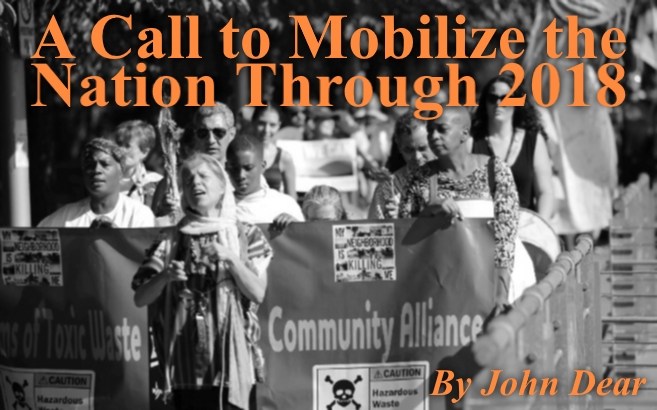
Banner illustration courtesy paceebene.org
While the media and the nation sit transfixed over the Trump scandals and attacks on democracy, those of us who work for justice and peace know that we have to keep working, resisting, and mobilizing people across the country if we are going to have the social, economic and political transformation we need for our survival.
In other words, we’ve only just begun. Instead of giving up, giving in, or throwing in the towel, instead of sitting glued to the tube, we’re going forward. The campaign for a new culture of nonviolence is on!
Read the rest of this article »
by Brandon Jacobsen
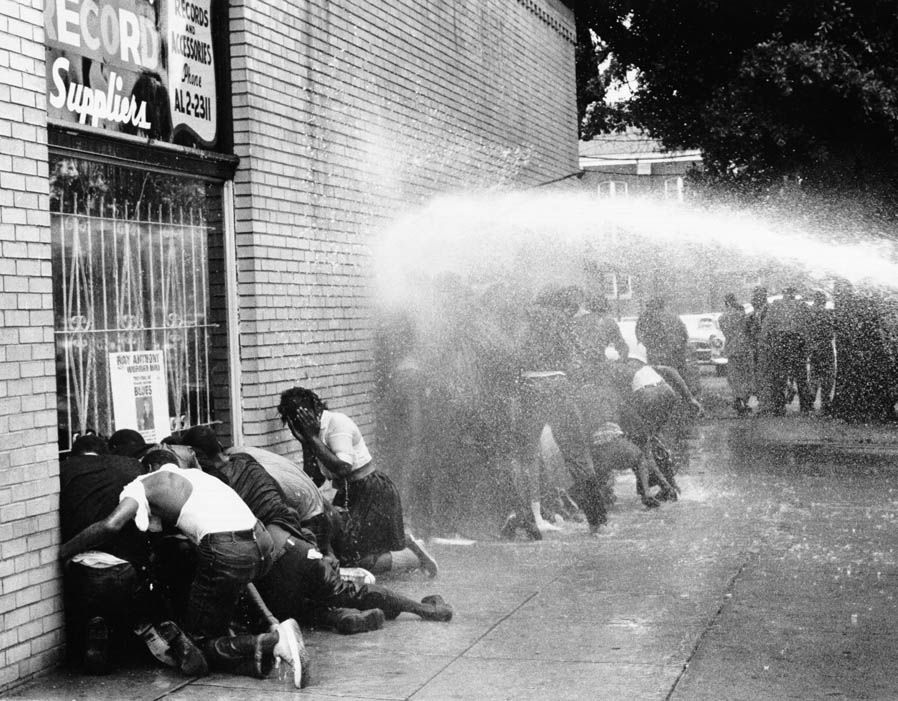
African American children attacked by police in Birmingham, AL; May 3, 1963; courtesy wagingnonviolence.org
The anti-Trump resistance movement has been effective in its nascent stage, utilizing public protests to signal opposition to the president’s plans. In taking to the streets, airports and congressional town hall meetings, the resistance has had a decisive impact on blocking the discriminatory travel ban on individuals from Muslim-majority countries, and on rendering the first iteration of the Republican health care replacement plan dead in the water.
Read the rest of this article »
by Gene Sharp
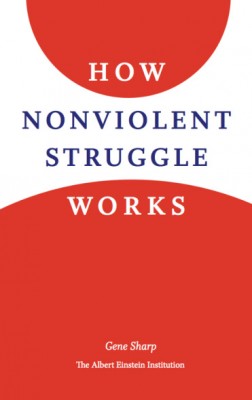
Dustwrapper art courtesy aeinstein.org
What nonviolent action is.
Nonviolent action is a technique of sociopolitical action for applying power in a conflict without the use of physical violence. Nonviolent action may involve acts of omission—that is, people may refuse to perform acts that they usually perform, are expected by custom to perform, or are required by law or regulation to perform; acts of commission—that is, people may perform acts that they do not usually perform, are not expected by custom to perform, or are forbidden to perform; or a combination of the two.
As a technique nonviolent action is not passive.
It is not inaction. It is action that is nonviolent.
As a technique, therefore, nonviolent action is not passive. It is not inaction. It is action that is nonviolent. These acts comprise a multitude of specific methods of action or “nonviolent weapons.”
Nearly two hundred have been identified to date, and without doubt, scores more already exist or will emerge in future conflicts. Three broad classes of nonviolent methods exist: nonviolent protest and persuasion, non-cooperation, and nonviolent intervention.
Nonviolent action provides a way to wield power in order to achieve objectives and to sanction opponents without the use of physical violence.
Read the rest of this article »
by Kazu Haga
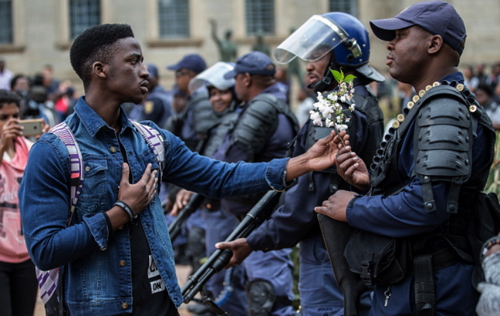
South African student presenting flowers to police; courtesy gettyimages.com
“Bernard? Oh yeah, he’s great. He was always the principles guy.” That was what an old Student Nonviolent Coordinating Committee (SNCC) organizer told me when I mentioned that I had been trained by Bernard Lafayette, co-author of the Kingian Nonviolence curriculum and a legend of the civil rights era. “I was always a strategies guy,” this elder went on to tell me. “I believed in nonviolence as an effective strategy, but Bernard was always talking about nonviolence as a principle.”
Read the rest of this article »














